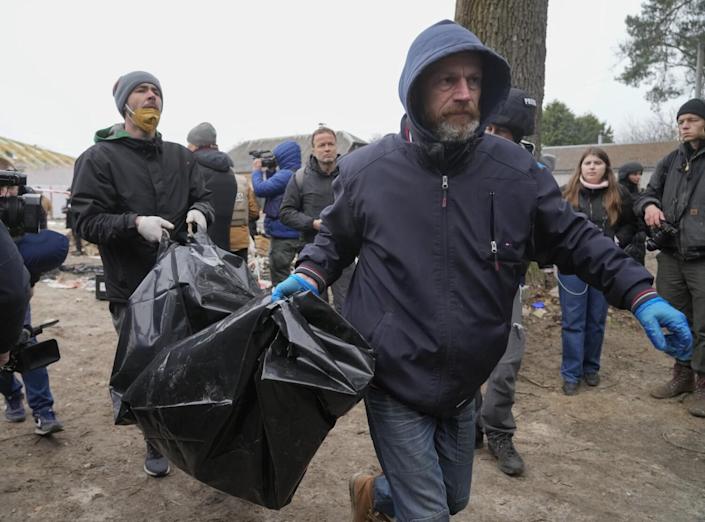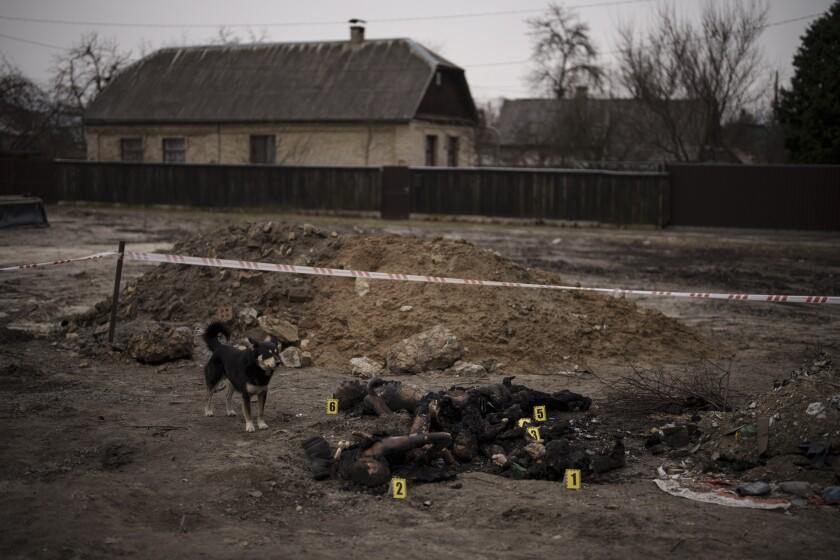
The corpses, charred and partially dismembered, were scattered among a pile of rubbish in one piece along the edges of a forest. Torn pieces of clothing stuck to tattered skin. Who was a man, who was a woman, who was an adult, who was a child – this could not be determined at a glance. A severed leg, badly charred, lay some distance away.
This tableau was about 100 yards from a playground with swings and slides, nestled under a woodsy shade.
A Ukrainian forensic team, each member wearing blue plastic gloves, worked with practiced speed. Pushing a group of reporters past, they ducked under the crime scene tape and hastily collected the bits and pieces and put them in black bags. Some mixing of parts seemed inevitable, so mixed were the carcasses. The workers zipped up the bags and hoisted them up to be taken to the morgue.

Northwest of Kiev, the capital, this city was a nice place to live, residents say. An idyll of forests, ponds and parks. Bucha retains a semi-rural atmosphere despite the inevitable advance of urban sprawl: shopping malls, condo towers, health clubs.
Now Bucha has become infamous as the ground zero of what Ukrainian authorities are calling a Russian war crime, a massacre targeting civilians, some found with their hands tied behind their backs, seemingly victims of summary executions. Video footage of victims lying along a street stunned the world – giving new impetus to Ukrainians’ demands for additional military aid to repel the attack and for more sanctions against Moscow.
The people “were killed in apartments, houses, blown up by shells,” President Volodymyr Zelensky told the United Nations on Tuesday, adding that some “were crushed by tanks in civilian cars in the middle of the road. Just for fun.”
At least 417 bodies of civilians have been discovered in towns near Kiev that have recently been recaptured from retreating Russian troops, Ukrainian officials say. Who they all were, exactly how they died are questions that are still being investigated as authorities struggle to identify the dead in a war that has stretched into its second month.
Russia has denounced the scenes from Bucha and other nearby towns as fake — a “staged anti-Russian provocation,” in the words of Moscow’s foreign minister Sergei Lavrov.
Here in Bucha and other suburbs, however, there is evidence of how the world, in its collective outrage sparked by Twitter videos of murders and satellite photos of troop movements, seems powerless to stop atrocities. Officials are continuing to collect bodies from shallow graves, streets, yards and other locations — including the vacant lot from which the six victims were removed Tuesday. The remains of the six, like those of several other victims, were burned in a clumsy attempt to cover up the crime, authorities say.

While collecting the dead, officials and the military are also busy with another task: clearing the many mines, piles of unexploded ordnance, and other war waste left behind in Bucha and other previously occupied towns. Signs with the warning ‘Danger: Mines’ dot the area. Some buildings may be booby-trapped, the military warns.
But the stray ammunition and equipment that littered the streets were not left intentionally. Their presence is a result of Russia’s ignominious mistreatment on the northern outskirts of Kiev and the subsequent withdrawal of its troops. Bucha isn’t just a graveyard of Ukrainian dead: it’s also a burial site of Russian war material, and possibly the site where Moscow’s apparent intention to quickly storm Kiev and take the capital ran aground.
A street in Bucha brutally bears witness to the pounding of Russian hardware and the failed ambitions of Russian President Vladimir Putin.
The burned remains of a dozen Russian tanks and armored personnel carriers, and at least one fuel tanker, mark a three-block stretch of the city. The sheer magnitude of destruction seems paradoxical in this tree-lined street, where chickens peck in adjacent gardens. Littered is a twisted jumble of ammunition, shards of metal, spools of wire, chunks of tires, cartridge belts, tank marks – a blackened tank turret stands in the front yard of a house.
It is a scene of destruction, as if a fire-breathing giant had expressed its wrath by tearing machines with steel claws to pieces. The wreckage is the result of a Ukrainian drone ambush apparently just days after the Russian invasion on February 24. It is unclear how many Russian soldiers were killed in the attack and how many escaped. Among the ruins lies a military boot with shattered bones in it.
Experts scoured the site and removed potentially dangerous ammunition. But journalists have been invited to roam the rubble – in a sort of surreal parade – broadcasting images of a routed Russian motorcade around the world.
The homes along this and other streets are largely empty. For Bucha it is now a ghost town. Most residents fled the Russian blitz and joined millions of others displaced. Curtains flutter through the blown-out windows of high-rise apartments where no one lives anymore.
Only about a tenth of Bucha’s pre-war population of about 30,000 remains, the mayor, Anatoly Fedoruk, has said. He has warned the townspeople to stay away until the mines and other hazards are cleared and power is restored.

Some residents seeking food and other help gathered outside a shopping center that had been hit by artillery and looted on Tuesday. Bullet grenades, shrapnel and broken glass lie on the property. Across the street was a scorched power plant, which didn’t seem too hopeful for workers looking to restore electricity.
Stray dogs fought over food scraps in the empty parking lot of the mall.
Many of the residents huddled outside were older. They were unable, or unwilling, to flee the Russian attack. They appeared on the street like ghosts, crouching in the biting cold. Many have been living for weeks without electricity, running water and heating.
“I would just like to be warm again — take a warm bath and be clean,” said a shivering Lisa Andreshenko, 46, who was one of those queuing for help. “It feels forever since we were hot, had a good hot meal.”
Fluff of snow blew across the commercial strip.
Despite the circumstances, Leonid Mutnichenko, a 58-year-old retiree, was cheerful. His family had a secret weapon: an old wood-burning stove that he and his mother had nearly thrown away, but which now—without heating or power—proved to be very useful indeed. He laughed at the cunning of it all.
He was quick to introduce his mother, Valentina Kusovkova, 80, draped in layers of scarves and overcoats. She didn’t complain about the cold.
She had bigger thoughts: “We have to save our country,” she said.
This story originally appeared in the Los Angeles Times.

